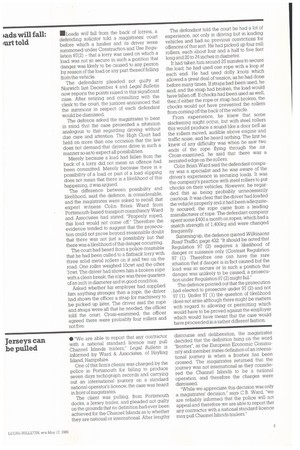'ads will fall: art told
Page 33

If you've noticed an error in this article please click here to report it so we can fix it.
'Loads will fall from the back of lorries, a defending solicitor told a magistrates court before which a haulier and its driver were summoned under Construction and Use Regulation 97(2) that a lorry was used on which a load was not so secure in such a position that danger was likely to be caused to any person by reason of the load or any part thereof falling from the vehicle, The defendants pleaded not guilty at Norwich last December 4 and Legal Bulletin now reports the points raised in this significant case: After retiring and consulting with the clerk to the court, the justices announced that the summons in respect of each defendant would be dismissed.
The defence asked the magistrates to bear in mind that the case presented a situtation analogous to that regarding driving without due care and attention The High Court had held on more than one occasion that the law does not demand that drivers drive in such a manner so as to expect all possibilities.
Merely because a load had fallen from the back of a lorry did not mean an offence had been committed. Merely because there is a possibility of a load or part of a load slipping does not mean that there is a likelihood of this happening, it was argued.
The difference between possibility and likelihood, said the defence, is considerable, and the magistrates were asked to recall that expert witness Cohn Brian Ward from Portsmouth-based transport consultancy Ward and Associates had stated: "Properly roped, this load would not come off." Therefore the evidence tended to suggest that the prosecution could not prove beyond reasonable doubt that there was not just a possibility but that there was a likelihood of this danger occurring.
The court had heard from a police constable that he had been called to a flatback lorry with three solid metal rollers on it and two on the road. One roller weighed 10cwt and the other 7cwt. The driver had shown him a broken rope with a clean break; the rope was three quarters of an inch in diameter and in good condition.
Asked whether his employer had supplied him anything stronger than a rope, the driver had shown the officer a strap for machinery to be picked up later. The driver said the rope and straps were all that he needed, the officer told the court. Cross-examined, the officer agreed there were probably four rollers and not five, The defendant told the court he had a lot of experience, not only in driving but in loading vehicles and had no previous convictions for offences of that sort. He had picked up four mill rollers, each about four and a half to five feet long and 20 to 24 inches in diameter.
It had taken him around 25 minutes to secure the load; he had used one rope with a loop at each end. He had used dolly knots which allowed a great deal of tension, as he had done before many times. If straps had been used, he said, and the strap had broken, the load would have fallen off. If chocks had been used as well, then if either the rope or strap had broken, the chocks would not have prevented the rollers from coming off the back of the vehicle.
From experience, he knew that some slackening might occur, but with steel rollers this would produce a sound like a door bell as the rollers moved, audible above engine and traffic noise, and he heard nothing. The first he knew of any difficulty was when he saw two ends of the rope flying through the air. Cross-examined, he said that there was a serrated edge on the rollers.
Cohn Brian Ward said the defendant company was a specialist and he was aware of the driver's experience in securing loads. It was the company's practice with steel rollers to put chocks on their vehicles. However, he regarded this as being probably unnecessarily cautious. It was clear that the driver had loaded the vehicle properly and it had been adequately secured; the rope came from a leading manufacturer of rope. The defendant company spent some £400 a month on ropes, which had a snatch strength of 1,400kg and were changed frequently.
Summing up, the defence quoted Wilkinsons Road Traffic, page 432: "It should be noted that Regulation 97 (2) requires a likelihood of danger or nuisance only (Contrast Regulation 97 (1). Therefore one can have the rare situation that if danger is in fact caused but the load was so secure or in such a position that danger was unlikely to be caused, a prosecution under Regulation 97(2) might fail."
The defence pointed out that the prosecution .had elected to prosecute under 97 (2) and not 97 (1). Under 97 (1) the question of likelihood does not arise although there might be matters with regard to allowing or permitting which would have to be proved against the employer which would have meant that the case would have proceeded in a rather different fashion.






















































































